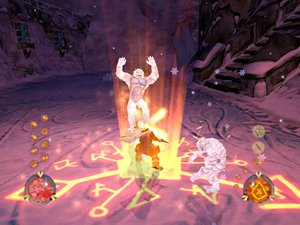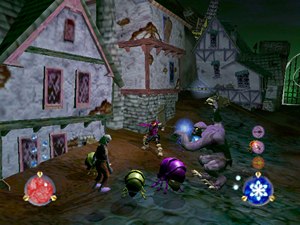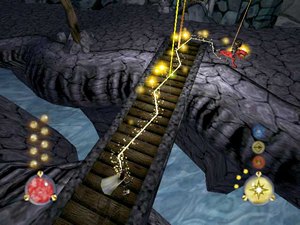The darkness again?
I’m glad I went to my class reunion. It was nice to see the old gang again
and catch up on old times. I can’t believe Harry
has gotten so big and so proficient, though I still think I could mop the Master‘s
floor with his four-eyed ass. It’s been twelve Simulrax moons since I graduated
and I see Big
O is still trying to conjure legs for himself. But some things never change.
Presto hasn’t
aged a day since we graduated, and for the life of me I can’t understand how
that damn moose
ever got a diploma. I bet his little pal
wrote all of his mystic arithmetic papers. Don’t even get me started on Dark
Paw…
Ah,
oh well, I miss the good old days. All these new students get to hone their
magical abilities by playing VR games. Lucky bastards.
One such game for advanced pupils is Nightcaster: Defeat the Darkness.
It’s a great looking game with a nice compliment of spells and a very easy combat
system, a magical brew containing ingredients from the archaic Missile
Command, Robotron
and Gauntlet. Oh yeah,
and an eye of newt. But like most potions these days, it’s got some nasty side
effects.
You take on the role of Arran the chosen mage. A great evil summoned by the
dark mage Nightcaster has blanketed the land. It is up to you to utilize your
magic stick from the enchanted Yew tree and the spells logged in the tome you
carry to reunite the four essences of magic – Fire, Water, Light and Dark –
in order to defeat Nightcaster and restore peace. Not a bad story, but not a
new one either.
Nightcaster is a fairly linear game played primarily from a top-down
perspective. As Arran, you will trek through various lands (buried city, the
lush Perth, the Ice Fortress, etc.) talking with villagers and officials who
conveniently tell you which way to go. You begin with a few paltry spells in
each of your four spell classes, with a plethora of other spells and upgrades
to find throughout the lands. The bulk of the gameplay has you constantly juggling
spells to dispatch enemies and the Gauntlet style creature dispensers
from which they emerge.
And that’s it. There is no item acquisition like we found in Drakan
and Baldur’s Gate: Dark
Alliance. Another gameplay element would be nice, such as alternate spells
that access other areas, which in turn house precious enchanted items…er..wait,
there are no items. D’oh!
There are a total of 48 spells in all, but you may only have 4 different spells
active and ready to cast. The remaining spells rest in your spell book awaiting
their need. It takes a lot of spell juggling and switching up on the fly to
defeat the game’s 35+ enemy types.
 Each
Each
of the enemy types is based on one of the four spell classes. The easiest way
to kill an enemy is to attack it using it’s diametrically opposed element, so
a purple (dark) creature is most susceptible to yellow (light) attacks. Likewise,
a fire creature’s main weakness is water-based spells, and so on.
But before you learn to juggle proficiently, you must learn the controls, which
are very intuitive. You move Arran about with the left analog stick. Moving
the right analog stick will make the the colored orb that rests on your magical
stick detach and float about. The orb can be guided anywhere within a certain
circumference around Arran. Aim the orb in the direction you wish to cast and
go nuts. It winds up functioning like an analog version of Smash TV.
The result is fast-paced fun. Arran can be running in one direction and cast
one of his gorgeous and colorful spells in a completely different direction.
It’s pretty cool and easy to perform.
Too bad the creature design is so lame. In the beginning, they throw a bunch
of little cat-type things and sentient globs of various colors your way. The
later levels are plagued with more interesting menaces, but not by much. You
often can’t make out what they’re supposed to be. This is due in part to primarily
playing from the top-down perspective, though even up closer the enemies are
bland. It’s just unforgivable in a world so rich and vibrant.
Indeed, textures are detailed and full of color – but the spells really steal
the show. The particle effects are just amazing, most noticeably for the light
and fire spells. Seeing a giant bolt of light streak across the ground and crack
the surface is good eye-candy.
Though it’s genuinely fun to romp around killing bad guys, it gets very repetitive.
Nightcaster winds up falling into much the same trap as the Gauntlet
games – good fun stunted by redundant action. It’s a solid adventure
(easily dusting Azurik), but greatly
limited by its monotonous gameplay. Even if it’s only a rental, this game will
likely impress even the most jaded student of the arcane ways.

-
Looks good
-
Awesome control system
-
Cool spells
-
Very limited gameplay
-
Terrible enemy design
-
Linear










